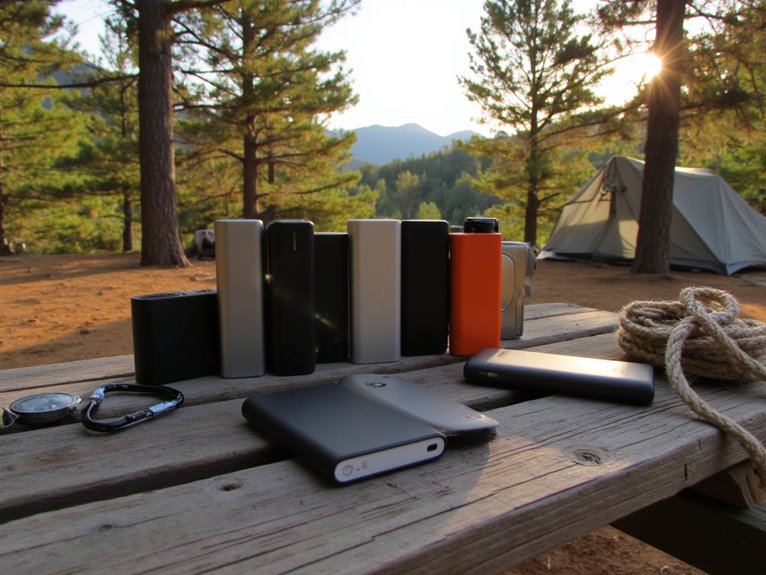How Do You Make a Campfire in the Wilderness?
To build a campfire in the wilderness, start by selecting a reliable fire starter, such as matches, lighters, or ferrocerium rods. Gather dry, brittle firewood, opting for hardwoods like oak or ash, and prepare the campsite by clearing leaves and debris. Create a fire pit and bed, and start with dry tinder material. Arrange kindling in a teepee shape, leaving space for airflow. Light the fire using your chosen starter, and maintain the flame by monitoring its size and adjusting fuel as needed. By following these steps, you'll be well on your way to a safe and enjoyable campfire experience, and there's more to discover to guarantee a successful and memorable outdoor adventure.
We are supported by our audience. When you purchase through links on our site, we may earn an affiliate commission, at no extra cost for you. Learn more. Last update on 15th January 2026 / Images from Amazon Product Advertising API.
Choosing the Right Fire Starter
When building a campfire, the right fire starter can make all the difference between a quick, easy ignition and a frustrating, failed attempt.
A reliable fire starter is vital for a successful campfire.
There are various types of fire starters available, including matches, lighters, ferrocerium rods, and flint and steel.
When selecting a fire starter, consider factors such as durability, water resistance, and wind resistance.
For instance, a waterproof match case or a windproof lighter can be a lifesaver in harsh weather conditions.
Additionally, ferrocerium rods and flint and steel are excellent options for those who prefer a more primitive approach.
Ultimately, the right fire starter will guarantee a safe and efficient campfire experience.
Gathering Materials for Fire
To construct a successful campfire, gathering the right materials is crucial.
This involves sourcing dry firewood, kindling materials, and tinder sources.
Find Dry Firewood
Dry firewood is essential for a successful campfire, and finding suitable logs is a crucial step in the process.
Look for logs that are dry, brittle, and have cracks or checks on the surface.
Avoid wood that is damp, rotten, or infested with insects.
Opt for hardwoods like oak, maple, or ash, as they burn more efficiently than softwoods like pine or fir.
Search for fallen branches, dead trees, or standing deadwood, making sure to follow any local regulations or guidelines.
Aim for logs that are roughly the same size, about 1-2 inches in diameter and 16-20 inches long, to facilitate a consistent burn.
Gather Kindling Materials
Kindling materials, including twigs, small sticks, and shredded bark, are essential for igniting the campfire, as they provide the necessary fuel for the flames to spread to the larger logs.
When gathering kindling, look for dry, brittle materials that will catch fire easily. Search for small branches, pine needles, or dry leaves on the forest floor.
Aim for materials that are about the size of a pencil or smaller. Collect a sufficient amount to create a small nest-like structure, roughly the size of a small bird's nest.
Avoid green or damp materials, as they will not ignite easily. Properly gathered kindling will help facilitate a successful campfire start.
Collect Tinder Sources
A variety of tinder sources, including dry moss, grass, or small, fluffy wood shavings, are essential for igniting a campfire, as they provide the initial spark that sets the kindling ablaze.
Collecting tinder is a vital step in building a campfire, as it allows the fire to start quickly and efficiently.
Look for dry, lightweight materials that catch fire easily, such as dry leaves, pine needles, or small twigs.
Avoid damp or wet materials, as they will hinder the fire's ignition.
Gather a sufficient amount of tinder to create a small nest or bed, about the size of your hand.
This will provide a solid foundation for your campfire, allowing it to grow and sustain itself.
Preparing the Campfire Site
Before building a campfire, carefully select and prepare a flat, level site away from trees, tents, and other flammable objects.
Verify the ground is clear of leaves, grass, and other combustible materials.
If the site is rocky or uneven, create a level surface by scraping away any debris or obstacles.
If it's a wet or damp environment, find a spot with good drainage to prevent water from accumulating.
Remove any twigs, pine needles, or other combustible materials from the surrounding area to minimize the risk of the fire spreading.
Finally, circle the site with rocks to contain the fire and define its boundaries.
Confirm a well-prepared site is essential for a safe and controlled campfire.
Building the Fire Pit
With the campsite prepared, the next step is to create a fire pit that will contain the flames and provide a safe burning area.
Clear the area of any leaves, grass, or other combustible materials. If you're in a designated campsite, look for a fire ring or a previously used fire pit.
If not, create a fire pit by scraping away the top layer of soil to expose the mineral soil underneath. Create a circle of rocks, about three to four feet in diameter, to contain the fire.
Verify the rocks are heat-resistant and not river rocks, which can explode when heated. If you're in a remote area, use rocks you find on site or bring your own fire ring. Make certain the rocks are heat-resistant and not river rocks, which can explode when heated.
Creating a Fire Bed
Every campfire begins with a solid foundation, and that starts with a well-prepared fire bed.
A fire bed is a cleared area of flammable materials, providing a safe and controlled space for your campfire.
To create a fire bed, start by selecting a flat, dry spot away from trees, tents, and other flammable objects.
Clear the area of leaves, grass, and other combustible materials, exposing the mineral soil beneath.
If the soil is damp, create a fire ring using rocks or by digging a shallow pit.
Rake the area smooth and remove any remaining debris.
A well-prepared fire bed guarantees a safe and contained campfire, minimizing the risk of uncontrolled spread.
Starting With Tinder Material
When starting a campfire, it's essential to begin with high-quality tinder material that ignites easily and burns well.
To establish a successful fire, it's vital to identify and prepare dry tinder sources, properly prepare the tinder material, and gather sufficient dry tinder to sustain the flames.
Dry Tinder Sources
Dry tinder sources, such as dry leaves, grass, or small twigs, are essential for starting a campfire, as they ignite quickly and burn intensely.
These materials are highly combustible and can help spark a fire even in damp or humid conditions.
Look for dry, brittle, and crumbly materials that can be easily ignited. Dry pine needles, small sticks, and shredded bark are also excellent tinder sources.
When collecting dry tinder, choose materials that are protected from the elements, such as under trees or in rocky outcroppings.
Avoid materials that are damp, rotten, or moss-covered, as they will not ignite easily.
Tinder Material Prep
With your dry tinder sources gathered, the next step is to prepare them for ignition by shredding or breaking them down into smaller, more combustible pieces.
This increases their surface area, allowing them to catch fire more easily.
Use your hands, a knife, or a tool to shred or break the tinder into fine strips or fragments.
For example, if using dry leaves, tear them into small pieces. If using grass, cut it into short lengths. Aim for a consistency similar to paper shreds or small twigs.
This preparation guarantees your tinder is ready to ignite quickly and sustain a flame. By doing so, you'll have a strong foundation for building your campfire, which will facilitate a robust blaze.
Gathering Dry Tinder
Gathering Dry Tinder
Identify potential tinder materials by scanning your surroundings for dry, fibrous plant life, such as dead grass, small twigs, or fallen leaves.
Look for materials that are brittle, crackle when bent, and have a rough, fuzzy texture.
Avoid moist or damp materials, as they may not ignite easily.
Collect a handful of dry tinder, focusing on smaller, more delicate pieces that will catch fire quickly.
Consider using dry moss, lichen, or small dry sticks.
Keep in mind that dry tinder is essential for starting a campfire, as it ignites easily and burns quickly, providing a foundation for larger logs to catch fire.
Adding Kindling to Fire
Your carefully arranged tinder now needs a helping of kindling to fuel the growing flames.
Kindling is small sticks and twigs that will help the fire spread and grow.
Gather small, dry sticks, about the size of a pencil, and place them in a teepee shape over the tinder.
Leave enough space in the center for air to flow and help the fire breathe.
Leave the kindling loose and not too compact, allowing for airflow and easy ignition.
Arrange the sticks in a crisscross pattern to allow for maximum airflow and flame spread.
As the fire grows, you can gradually add larger logs to sustain the fire.
Building the Fire Structure
The fire structure consists of a deliberate arrangement of fuel and oxygen, carefully crafted to facilitate a robust and sustainable flame.
To build a sturdy fire structure, start by placing two to three logs parallel to each other on the fire pit or ring. These logs will serve as the base of your fire.
Next, arrange smaller twigs and sticks perpendicularly across the logs, leaving sufficient space in the center for air to flow. This lattice-like structure allows oxygen to circulate, feeding the flames.
Continue to add more kindling, gradually increasing the size of the material as you build upwards.
A well-constructed fire structure is essential for a campfire that burns efficiently and safely.
Lighting the Campfire
With tinder and kindling in place, it's time to introduce the spark that will bring your campfire to life.
There are several methods to ignite your fire, including matches, lighters, and firestarters.
If using matches, strike them gently to avoid blowing out the flame. Hold the match to the tinder until it catches, then gradually add more kindling as the fire grows.
For lighters and firestarters, follow the manufacturer's instructions.
Once the fire is burning steadily, add larger logs to sustain it. Be cautious of wind and verify the fire is contained within the fire ring or pit.
Monitor the fire's size and adjust as needed to maintain a safe and controlled blaze.
Maintaining the Campfire
Once the campfire is burning steadily, attention turns to maintaining its size and intensity. This is vital to provide a safe and enjoyable camping experience. Proper maintenance also helps to conserve fuel and reduce the risk of forest fires.
To maintain your campfire, remember to:
- Monitor the fire's size and adjust the fuel as needed
- Keep a bucket of water or a fire extinguisher nearby in case the fire gets out of control
- Arrange the logs in a teepee shape to allow for good airflow
- Stir the ashes regularly to ensure complete combustion and minimize smoke



